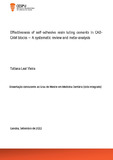| dc.contributor.advisor | PINHO, TERESA MARIA DA COSTA | |
| dc.contributor.author | Vieira, Tatiana Leal | |
| dc.date.accessioned | 2023-01-31T14:30:49Z | |
| dc.date.available | 2023-01-31T14:30:49Z | |
| dc.date.issued | 2022 | |
| dc.identifier.uri | http://hdl.handle.net/20.500.11816/4204 | |
| dc.description.abstract | Introdução: Os cimentos resinosos auto-adesivos (SARCs) são amplamente utilizados pelas suas propriedades mecânicas e redução da complexidade dos protocolos de cimentação, ligando-se à superfície dentária sem a necessidade de condicionamento ácido ou sistema adesivo. O sucesso da reabilitação estética e funcional com blocos fabricados por Computer-aided design and computer-aided manufacturing (CAD-CAM) depende da eficácia do cimento utilizado. Existem protocolos adesivos mais eficazes do que outros para cada bloco CAD-CAM. Os SARCs são geralmente de dupla cura, sendo foto-ativados mas também autopolimerizáveis, sofrendo aumento ligeiro do pH, inicialmente ácido, permitindo a auto-adesividade, tornando-se o cimento mais resistente aos fenómenos de hidrólise.
Objectivos: O principal objetivo foi analisar o desempenho mecânico e a eficácia dos SARCs quando utilizados para cimentar blocos CAD-CAM à estrutura dentária.
Materiais e métodos: Foi realizada uma revisão integrativa sistemática com artigos obtidos através da pesquisa nas bases de dados MedLine/PubMed e Science Direct, combinando as palavras-chave na fórmula de pesquisa Booleana: [("dental" ou "tooth") AND ("self-adhesive") AND ("luting" ou "cement")) AND "CAD-CAM") NO ("endodontics" ou "implants")] de 1 de Maio de 2022 a 31 de Julho de 2022.
Resultados: A pesquisa encontrou 199 artigos. Após a aplicação dos critérios de inclusão e exclusão, foram selecionados 31 estudos para avaliação da qualidade. Os Lava Ultimate e Vita Enamic foram os blocos CAD-CAM mais testados. O Rely X Ultimate 2 foi o cimento resinoso mais utilizado, seguido pelo Rely X Unicem, Rely X Ultimate e Rely X U200, e o μTBS MPa foi o teste mais utilizado. A meta-análise confirmou a eficácia dos protocolos SARCs para aderir aos blocos CAD-CAM mas que apesar de serem denominados universais o seu desempenho é dependente do substrato (P<0,05).
Conclusões: Os SARCs mostram resultados promissores, mas existem diferenças entre eles. O desempenho da ligação dos SARC aos blocos CAD-CAM está dependente do tipo dos materiais utilizados. Para melhorar a durabilidade e estabilidade das restaurações, deve ser considerada a combinação apropriada de materiais. | pt_PT |
| dc.description.abstract | Introduction: Self-adhesive resin cements (SARCs) are widely used for their mechanical properties and for reducing the complexity of cementation protocols, bonding to the tooth surface without the need for acid conditioning or an adhesive system. The success of aesthetic and functional rehabilitation with ceramic blocks manufactured by Computer-aided design and computer-aided manufacturing (CAD-CAM) depends on the effectiveness of the cement used. There are more effective adhesive protocols than others for each CAD-CAM block. SARCs are generally dual-cured, being photo-activated but also self-cured, suffering a slight increase in the initially acidic pH, allowing self-adhesiveness, and making the cement more resistant to hydrolysis phenomena.
Objectives: The main goal was to analyze the mechanical performance and efficacy of SARCs systems when used to cement CAD-CAM blocks to the tooth structure.
Materials and methods: A systematic integrative review was conducted with articles obtained by searching the MedLine/PubMed and Science Direct databases, combining the keywords in the Boolean search formula: [(“dental” or “tooth”) AND (”self-adhesive”) AND (“luting” or “cement”)) AND “CAD-CAM”) NOT (“endodontics” or “implants”)] from May 1 of 2012 to July 31 of 2022.
Results: The survey retrieved 199 articles. After applying the inclusion and exclusion criteria, 31 studies were selected for quality assessment. Lava Ultimate and Vita Enamic blocks were the most tested CAD-CAM blocks. Rely X Ultimate 2 was the most widely used resin cement, followed by Rely X Unicem, Rely X Ultimate and Rely X U200, and μTBS MPa was the most used test. The meta-analysis confirmed the efficacy of SARCs protocols to adhere CAD-CAM blocks but that despite being denominated universal, their performance is substrate-dependent (P<.05).
Conclusions: SARCs show promising results, but there are differences between them. The performance of SARC binding to CAD-CAM blocks depends on the materials used. The appropriate combination of materials must be considered to improve the durability and stability of restorations. | pt_PT |
| dc.language.iso | por | pt_PT |
| dc.rights | info:eu-repo/semantics/openAccess | pt_PT |
| dc.subject | Dental | pt_PT |
| dc.subject | Tooth | pt_PT |
| dc.subject | Self-adhesive | pt_PT |
| dc.subject | Luting | pt_PT |
| dc.subject | Cement | pt_PT |
| dc.subject | CAD-CAM | pt_PT |
| dc.title | Effectiveness of self-adhesive resin luting cements in CADCAM blocks - A systematic review and meta-analysis | pt_PT |
| dc.type | info:eu-repo/semantics/masterThesis | pt_PT |
| dc.identifier.tid | 203121694 | pt_PT |
| thesis.degree.name | Mestrado em Medicina Dentária | pt_PT |

